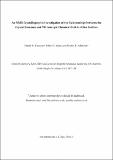Files in this item
An NMR crystallographic investigation of the relationships between the crystal structure and 29Si isotropic chemical shift in silica zeolites
Item metadata
| dc.contributor.author | Dawson, Daniel M. | |
| dc.contributor.author | Moran, Robert F. | |
| dc.contributor.author | Ashbrook, Sharon E. | |
| dc.date.accessioned | 2018-06-16T23:32:05Z | |
| dc.date.available | 2018-06-16T23:32:05Z | |
| dc.date.issued | 2017-07-20 | |
| dc.identifier | 250251036 | |
| dc.identifier | 05b17972-26aa-43ea-a3e9-04a49df7b1e4 | |
| dc.identifier | 85025841935 | |
| dc.identifier | 000406355700024 | |
| dc.identifier.citation | Dawson , D M , Moran , R F & Ashbrook , S E 2017 , ' An NMR crystallographic investigation of the relationships between the crystal structure and 29 Si isotropic chemical shift in silica zeolites ' , Journal of Physical Chemistry C , vol. 121 , no. 28 , pp. 15198-15210 . https://doi.org/10.1021/acs.jpcc.7b03730 | en |
| dc.identifier.issn | 1932-7447 | |
| dc.identifier.other | ORCID: /0000-0002-4538-6782/work/56638994 | |
| dc.identifier.other | ORCID: /0000-0002-8110-4535/work/59464843 | |
| dc.identifier.uri | https://hdl.handle.net/10023/14142 | |
| dc.description | This work was supported by the ERC (EU FP7 Consolidator Grant 614290 ‘‘EXONMR’’) and EPSRC for computational support through the Collaborative Computational Project on NMR Crystallography (CCP-NC), via EP/M022501/1). SEA would also like to thank the Royal Society and Wolfson Foundation for a merit award. The research data supporting this publication can be accessed at DOI: 10.17630/2daa020f-315d-451e-bdec-9a788ab810fe. | en |
| dc.description.abstract | NMR crystallography has recently been applied to great effect for silica zeolites. Here we investigate whether it is possible to extend the structural information available from routine NMR spectra via a simple structure-spectrum relationship. Unlike previous empirically-derived relationships that have compared experimental crystal structures for (often disordered) silicates with experimental NMR spectra, where the structure may not be an accurate representation of the material studied experimentally, we use NMR parameters calculated by density functional theory (DFT) for both model Si(OSi(OH)3)4 clusters and also extended zeolitic SiO2 frameworks, for which the input structure corresponding to the NMR parameters is known exactly. We arrive at a structure-spectrum relationship dependent on the mean Si–O bond length, mean Si–O–Si bond angle, and the standard deviations of both parameters, which can predict to within 1.3 ppm the 29Si isotropic magnetic shielding that should be obtained from a DFT calculation. While this semi-empirical relationship will never supersede DFT where this is possible, it does open up the possibility of a rapid estimation of the outcome of a DFT calculation where the actual calculation would be prohibitively costly or otherwise challenging. We also investigate the structural optimisation of SiO2 zeolites using DFT, demonstrating that the mean Si–O bond lengths all tend to 1.62 Å and the distortion index tends to <2.0°, suggesting that these metrics may be suitable for rapid validation of whether a given crystal structure represents a realistic local geometry around Si, or merely a bulk average with contributions from several different local geometries. | |
| dc.format.extent | 1341189 | |
| dc.format.extent | 1048085 | |
| dc.language.iso | eng | |
| dc.relation.ispartof | Journal of Physical Chemistry C | en |
| dc.subject | QD Chemistry | en |
| dc.subject | DAS | en |
| dc.subject.lcc | QD | en |
| dc.title | An NMR crystallographic investigation of the relationships between the crystal structure and 29Si isotropic chemical shift in silica zeolites | en |
| dc.type | Journal article | en |
| dc.contributor.sponsor | European Research Council | en |
| dc.contributor.sponsor | EPSRC | en |
| dc.contributor.institution | University of St Andrews. School of Chemistry | en |
| dc.contributor.institution | University of St Andrews. EaSTCHEM | en |
| dc.identifier.doi | 10.1021/acs.jpcc.7b03730 | |
| dc.description.status | Peer reviewed | en |
| dc.date.embargoedUntil | 2018-06-16 | |
| dc.identifier.url | http://pubs.acs.org/doi/suppl/10.1021/acs.jpcc.7b03730 | en |
| dc.identifier.grantnumber | 614290 - EXONMR | en |
| dc.identifier.grantnumber | EP/M022501/1 | en |
This item appears in the following Collection(s)
Items in the St Andrews Research Repository are protected by copyright, with all rights reserved, unless otherwise indicated.


